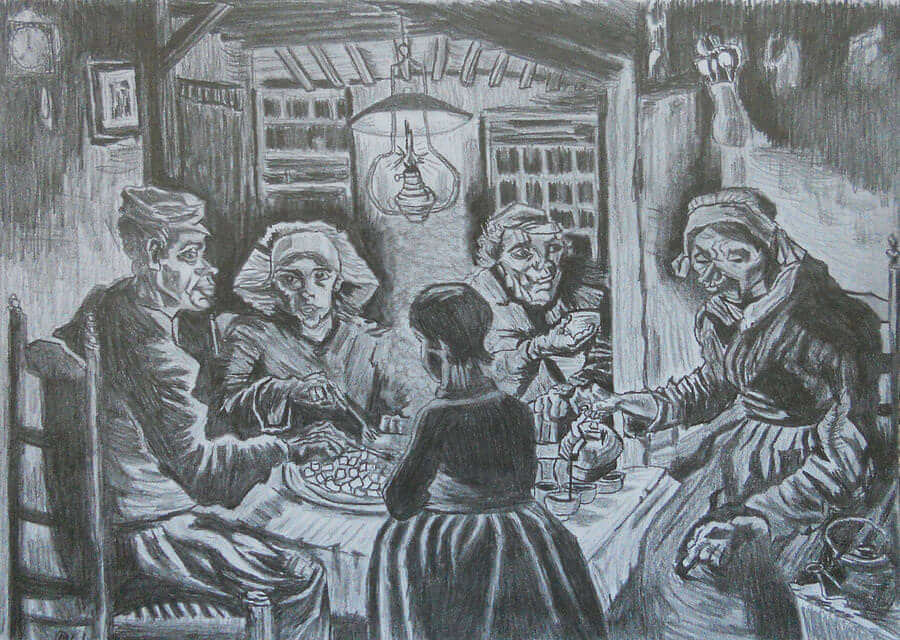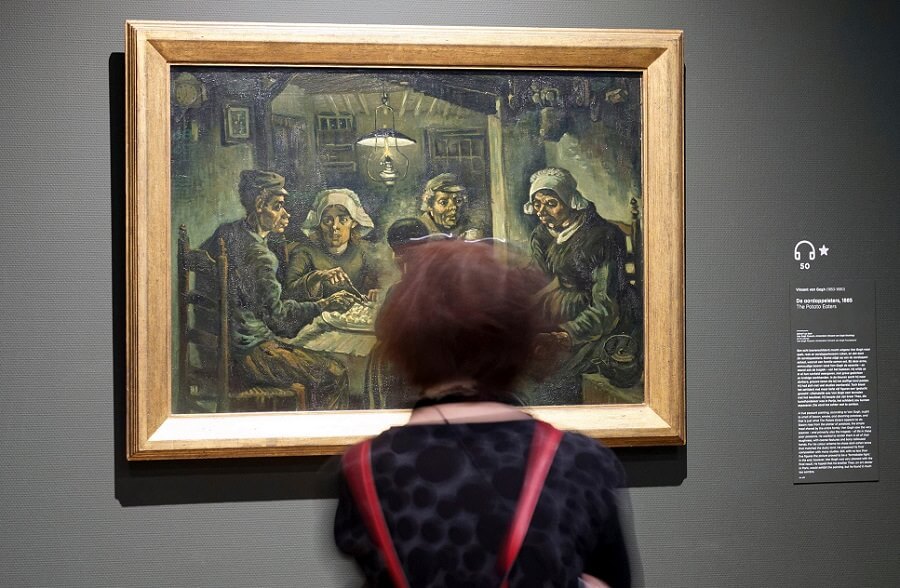10 Secrets of Potato Eaters by Vincent van Gogh

Conceived as a summation of Van Gogh's work and study up to that time, The Potato Eaters also expresses most strongly and fully his social and moral feeling. He was a painter of peasants, not for the sake of their picturesqueness - although he was moved by their whole aspect - but from a deep affinity and solidarity with poor people, whose lives, like his own, were burdened with care. He found in their common meal the occasion in which their humanity and moral beauty are strikingly revealed; they appear then as a close community, based upon work and the sharing of the fruits of work. The table is their altar and the food a sacrament for each one who has labored. Under the single light at this common table, the solitude of the individual is overcome and the harshness of nature, too - yet each figure retains a thought of his own and two of them seem to be on the brink of an unspoken loneliness. The colors of the dark interior - blue, green, and brown - bring us back to nature outside. In the homely faces the hands of these peasants - in color and modeling they are like the potatoes that nourish them - there is a touching purity. It is the purity of familial souls in whom care for one another and the hard struggle with the earth and weather leave little place for self-striving.

The composition has a rough strength, in part the result of a naive placing. And in Van Gogh's clumsiness, which conveys also, as he intended, the clumsiness of his people, there is a source of movement. The grouping of the figures at the sides of the table is odd; the wall between the two figures at the right creates a strange partitioning of the intimate space.
Within the gloom of the dark tonality are remarkable bits of painting, prepared by Van Gogh's tenacious studies: the cups of coffee, with their gray shadows; the potatoes on the platter; and the superb heads, which in their isolation from one another betray the portrait studies from which they were copied. The eyes of two figures at the left shine with an inner light and the shadows on their features are more a modeling of character than a phenomenon of darkness. Van Gogh wrote shortly after:
I like so much better to paint the eyes of people than to paint cathedrals"
The Potato Eaters was a synthesis of countless studies of peasants' heads, of people absorbed in work and handicrafts, which van Gogh painted that winter in the poor cottages in the village. He had to paint a whole series of pictures in order to achieve any real closeness with these intractable people, and his approach resulted in a final triumph.
You see, if I am to get ahead at all I have to paint fifty heads, precisely because it goes so well. As soon as possible, one after the other. I have worked it out, but it can't be done, with all my strength (which I shall gladly invest, as far as effort and exertion are concerned), without putting in extra work.
In Letter of November, 1884 he told Theo of the workload he had set himself and requested more money, after all, the models he was now using had to be paid too. Van Gogh adhered to his work schedule through to April the following year, and over forty paintings of peasants' heads plus two dozen close-up studies of various kinds of cottage work have survived from this time
It would be difficult to put these pictures in chronological order. In the course of his efforts to include the people of Nuenen in his art, Van Gogh himself made only comments of a general nature:
I want the subject to follow from the character".
However, through these pictures, we might outline a rough description of Van Gogh's methods as follows. First he would restrict himself to bust portraits. He had a preference for placing figures in profile, their silhouettes (in dark colours) set off against the monochrome gloom of the background,- and he would dwell on the material of caps and kerchiefs, the folds and crinkles in the linen. In the portraits where the sitters are seen full-face, Van Gogh strikingly avoids meeting their careworn gaze and simply records the villagers look full of mistrust; they remain in some unfathomable depths of their own, not communicating with their vis-a-vis, gazing straight past at some imaginary world. The dark setting and spiritual depth of this painting evoke one of Van Gogh's favorite artists, Rembrandt .

The painting of The Potato Eaters marked a turning point in Van Gogh's artistic life, and is now considered as his first true masterpiece.
10 Secrets of "The Potato Eaters"
1) Upon completion of The Potato Eaters, Van Gogh thought it was his best work to date; however, he considered his later masterpiece The Starry Night to be a failure.
2) Van Gogh created three surviving studies of The Potato Eaters prior to his final artwork.
3) He also printed a lithograph of the work, which he sent to his brother Theo in Paris, hoping for some feedback.
4) The artist used the de Groots, a Netherlands farming family of his acquaintance, as the subjects of The Potato Eaters. Van Gogh also painted the de Groot homestead in his 1885 work, The Cottage.
5) The Potato Eaters has been stolen twice. In 1989, thieves nabbed an early version of the work from the Kroller-Muller Museum, along with the artist's Weavers and Sunflowers. The final version of
the Potato Eaters was part of a group of 20 artworks stolen from The Vincent Van Gogh Museum in 1991. Both versions have since been recovered.
6) The artist spent an entire winter practicing his rendering of heads and hands before painting the final version of The Potato Eaters.
7) Dissatisfied with the flesh tones he first used to paint the heads of the peasants, Van Gogh repainted them so they were the color of "a really dusty potato."
8) Van Gogh painted 20 or more studies of Gordina de Groot, the young woman also pictured in the "The Potato Eaters" family group.
9) Before Van Gogh started painting The Potato Eaters, he moved in with his parents in Nuenen in Brabant, where he produced more than a hundred portrait studies of local farm labourers.
10) The Potato Eaters would remain in the possession of the Van Gogh family from just after Vincent's death in 1890 until 1962. It then became the property of the Vincent Van Gogh Foundation. It is now on permanent loan to
Amsterdam's Van Gogh Museum.




















